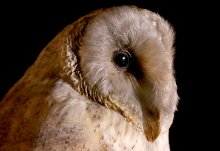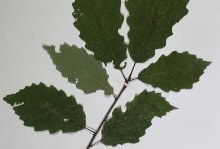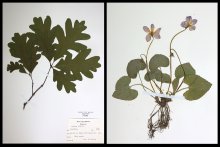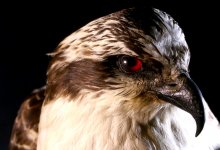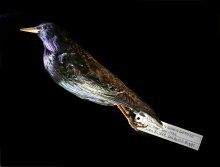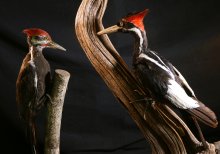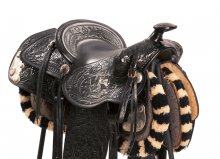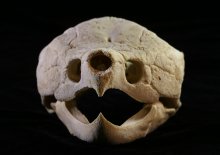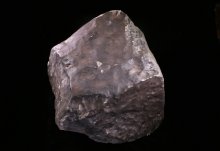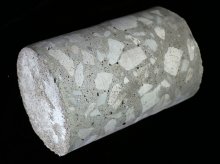Modern Era (1917-present)
The state’s Modern Era has been one of continued growth and change. Following World War I and the nation’s greatest economic collapse, public works projects of the New Deal put people to work on civic projects, such as building roads and infrastructure, and brought history to life by protecting a number of historic places around the state. The Federal Arts Program of the W.P.A. paid artists to create paintings, prints, sculptures, and murals for civic beautification, pride, and capturing the moment. Beginning in 1941, the state’s agricultural and manufacturing sectors and the sacrifices of citizen-soldiers played an important role in making the United States a leader on the world stage.
The Barn Owl’s name sounds like it should be found just about everywhere in rural Illinois. The truth is that Barn Owl (Tyto alba) numbers declined so precipitously by the 1960s that they landed on the Illinois list of threatened or endangered species. In recent years, however, the Barn Owl has made a comeback.
Dwarf Chinkapin Oak (Quercus prinoides) is a shrubby, clone-forming oak native to eastern and central North America. In Illinois, Chinkapin Oak has been sometimes misidentified as Dwarf Chinkapin Oak, and a true Dwarf Chinkapin Oak plant has not been observed in the wild until recently.
In 1907, Mrs. James C. Fessler of Rochelle suggested to state officials that Illinois schoolchildren vote for a state tree and flower. Senator Andrew J. Jackson of Rockford introduced a bill making it official, and in 1908 the blue violet became the state flower, and the oak became the state tree.
While the American Bald Eagle was getting all the attention for its comeback in the lower 48 states, another bird of prey was quietly making a comeback of its own. The Osprey (Pandion haliaetus), a fish-eating hawk, has also benefitted from some of the same legal protections and conservation measures that have assisted the Bald Eagle. The Osprey has a white head with a dark eye stripe. It hunts by folding its wings and making a steep dive into the water feet first to catch fish.
European Starlings (Sturnus vulgaris) are ubiquitous across North America, where they compete with native cavity-nesting birds for space. They reportedly were brought to the Americas by a fan of William Shakespeare who set out to introduce every bird mentioned in the Bard’s work to the New World. In 1890, Eugene Schieffelin released 60 starlings in Central Park in New York City, and the rest was “to be.” Immigrants brought many plants and animals from home when they resettled in the New World, and most of them behaved well enough. However, a few became invasive, meaning they cause ecological or economic harm.
This specimen of the Ivory-billed Woodpecker (Campephilus principalis) (here compared with the common Pileated Woodpecker on the left) is not from Illinois. The only Illinois records we have are observations from naturalists, mostly in the 1800s. John James Audubon, the famous bird artist, encountered calling Ivory-billed Woodpeckers in the 1820s on both sides of the Ohio River where it meets the Mississippi River at Cairo. Southern Illinois was the far northern extent of the species at that time.
Brace Beemer, who portrayed the Lone Ranger on radio station WXYZ in Detroit, Michigan, used this Western saddle. Beemer was born in Mt. Carmel in 1902, and made personal appearances for The Lone Ranger radio show on a white horse called Silver. Thousands of children turned out for the appearances. Millions of children and adults listened to the serialized program three times a week.
The unmistakable ridges of the carapace (or shell) tell us right away that this prehistoric-looking creature is the Alligator Snapping Turtle (Macrochelys temminckii). It is our largest freshwater turtle, weighing up to 200 pounds. They lie in wait for prey submerged underwater and try to lure a meal into range by means of a wormlike appendage on the floor of their mouths. When a fish or other aquatic animal moves in to investigate, the turtle snaps its jaws shut.
The first and largest meteorite ever to strike Illinois (at least in recorded history) fell to Earth in three large pieces near the town of Tilden in southwest Illinois 91 years ago. About 1 p.m. on July 13, 1927, witnesses reported a sound like an airplane passing overhead and backfiring. In fact, a large meteorite exploded three times as it streaked through the sky, rattling windows and shaking dishes.
The fabled highway, U.S. Route 66, which stretched from Chicago, Illinois, to Santa Monica, California, revolutionized transportation and the relationship Americans had with their cars. Several segments of the original highway can still be found in Illinois. One such section of original pavement was sampled by the Illinois Department of Transportation in Macoupin County, where the old road intersects a new high-speed rail crossing. The pavement core can inform materials engineers about the historic concrete used in its construction and its present condition. It can also help guide preservation and restoration efforts of remaining segments of the historic roadway.
Pages






